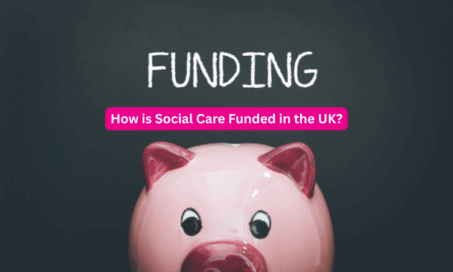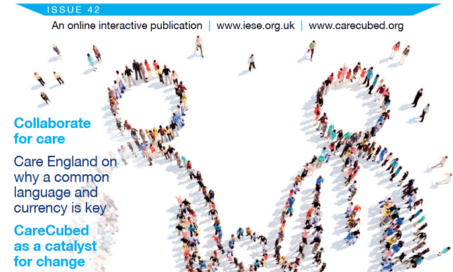
Published in All news on 15/10/2022
CareCubed offers a transparent solution to help local authorities and care providers come to an agreement on the cost of placements to achieve ‘fair price, fair care’.
The tool is available as an annual subscription for care commissioners (local authorities and Clinical Commissioning Groups) and providers to help price adult services and children’s services in England and Scotland. iESE plans to launch other modules soon.
What is CareCubed?
Care commissioners have a duty under the Care Act to secure the right placement for an individual’s needs. There is also a duty to ensure placements offer value for money for the public purse. It has historically been difficult to compare the options available when specifying a care package but the iESE tool CareCubed has revolutionised the market and brought transparency to negotiations between care providers and commissioners.
Historically, when complex care has been required, or is in the sensitive area of children’s care, some local authorities have had a blank cheque book approach. With some placements priced around £3,000-£5,000 per week this is unsustainable, but councils need providers to continue offering their services whilst working closely with them to understand their cost base and help shape their local care market.
CareCubed is the market-leading, care cost calculator which generates a guide price for a new care placement, or one which is being renegotiated, based on the details entered about the client. The tool produces an initial guideline of the cost of care as a starting point for discussions between a provider and commissioner based on the information input.
The tool works using model benchmarking data, updated annually, which reflects all costs, including those which may change as a result of regulation, such as minimum living wage or pension rules, or due to inflation or changes in the labour market. The tool factors in local and regional specifics and national changes. For example, iESE made temporary changes to the tool to reflect costs affected by the pandemic, such as the increased cost of PPE, greater need to use agency staff to cover staff absence and the cost of providing services in the setting which would usually be sourced outside.
How does it work?
Each subscriber organisation has their own secure account with multi-user access across devices, including laptops, tablets and smart phones. The tool, which is intuitive, easy-to-use and fully GDPR compliant, records each case input and the decision made. This means that next time an individual’s care is assessed it is easy to see what was decided last time and why. It provides evidence that the organisation has given consideration to ensuring the cost is fairly reached and that the individual’s needs are being met. It also gives a bird’s eye view across all cases, helping to shape strategic decisions.

What does it cost and who is it for?
iESE operates a tiered pricing structure to suit the range of organisation sizes for both commissioners and providers.
There are currently a third of all UK councils signed up to the tool. Provider take up is lower, but we are seeing more come on board as they recognise the transparency CareCubed gives to negotiations.
There are currently two versions of the tool –adult and children’s – and both are also available as a Scottish version using Scottish data. iESE is currently working on the launch of some other versions of the tool too, including an NHS version, eldercare and mental health.
The tool will often help save on placement prices, although it is not designed to pressure providers or squeeze them out of the market. Providers are also able to sign up and, through collaboration, can help ensure the local care market is sustainable. As well as helping with cost savings, there are occasions when case reviews lead to an uplift being agreed because the provider’s costs are well evidenced through the tool for the local authority to see.
Jim Weir, a Senior Consultant at iESE, said: “From what I have seen from going into local authorities to teach them about CareCubed is that not many are looking at care commissioning this way. The hours being input for care are all extremely high. Our Hierarchy of Need table is available to all CareCubed users to act as a graphic reminder of the options.”
As iESE’s flagship digital tool, the organisation is committed to its continual development and investment in the product. We offer email and online support as part of the subscription fee and access to online documentation and user forums for sharing experience. To find out more about how iESE supports CareCubed users, see page eight.
CareCubed is an evidence-based tool that uses an effective combination of verified national benchmarking data, local intelligence and individual outcomes to facilitate a meaningful dialogue between commissioners and providers”, said Kate Alcock, Interim Head of Strategic Commissioning at Cornwall Council.
“Through the use of iESE’s care pricing tool, some providers have really embraced the opportunity to work in partnership with the council, substantially remodeling their provision to better match individuals’ needs.”
“CareCubed is an evidence-based tool that uses an effective combination of verified national benchmarking data, local intelligence and individual outcomes to facilitate a meaningful dialogue between commissioners and providers”
Kate Alcock, Interim Head of Strategic Commissioning at Cornwall Council
Whilst providers are able to subscribe, the tool also has sharing and collaboration functions meaning commissioners can input their data, download the information as an Excel spreadsheet or PDF and share this with the provider, regardless of whether they also use CareCubed or not.
Meeting duty of care requirements
CareCubed’s structured and person-centred approach to recording needs makes it easy to track the requirements of people with complex conditions, including those with fluctuating or intermittent needs, rehabilitation or re-enablement goals and those with deteriorating conditions. This approach helps commissioners and providers ensure needs are met in the most cost-efficient way whilst delivering flexible and transparent support.

The tool also encourages commissioners and providers to consider the level of care needed when sourcing placements. The CareCubed Hierarchy of Need pyramid (see above) aims to get commissioners to consider what other options are available before automatically opting for the most expensive type of support (one-to-one care).
By working through the hierarchy, care commissioners might be able to reduce the hours of care commissioned, reducing the overall cost for the local authority, and helping the client retain independence. The top tier of one-to-one care is the most restrictive for the individual, whilst the bottom tier of technology helps the individual remain independent.
To find out more about CareCubed download your free copy of our latest edition of Transform magazine which is dedicated to this tool: https://issuu.com/ksagency.co.uk/docs/transform_20new_20style_20019_web
Or to speak to us directly and sign up to a free online workshop for CareCubed, email carecubed@iese.org.uk







